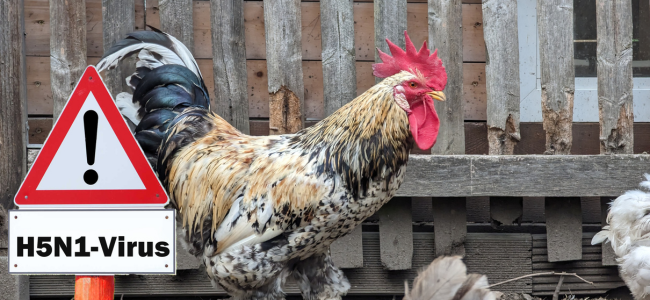
Avian Flu and Workplace Safety
Though sustained human-to-human transmission has not been observed, infections have occurred after unprotected contact with infected animals.
- By Stasia DeMarco
- Feb 11, 2025
As avian influenza continues to impact poultry, livestock, and wildlife, workplace safety has become a top concern for employees and employers handling potentially infected animals. The virus, known for its high mortality rate in birds, has now been detected in a range of mammals, including dairy cattle, raising concerns about occupational exposure.
While there is currently no evidence of sustained human-to-human transmission, infections among workers have occurred following unprotected contact with infected animals. State and federal agencies, including OSHA and the CDC, are urging vigilance and the use of protective measures to minimize risk.
Avian influenza is classified into two types: low pathogenic avian influenza, which causes mild illness, and highly pathogenic avian influenza, such as H5N1, which is highly contagious and often fatal in poultry. Since the outbreak began, millions of birds have been culled across the United States to curb the spread of the virus.
In a report from the CDC, H5N1 viruses usually do not infect people, but there have been some sporadic cases of human infection. H5N1 bird flu in people has been mild to severe, including death. The signs and symptoms of H5N1 bird flu are varied. People with H5N1 can have red and irritated eyes, called conjunctivitis. They can also have a fever or cough. Sometimes people sick with H5N1 bird flu also get pneumonia, which is an infection of the lungs.
The virus has also been detected in a variety of mammal species, including foxes, bears, skunks, raccoons, seals, and domestic cats, primarily those that scavenge infected birds. In 2024, H5N1 was confirmed in U.S. dairy cattle for the first time, signaling an expanded risk of exposure for agricultural workers.
According to OSHA, employees at a greater risk include poultry workers, dairy farm workers, slaughterhouse employees handling lactating cattle, veterinarians, and animal control personnel. These workers face potential exposure through direct contact with infected animals, contaminated surfaces, or raw milk.
Protective Measures for Workers
OSHA recommends strict precautions to prevent infection. Workers should:
- Avoid unprotected contact with infected animals, carcasses, feces, or contaminated surfaces.
- Practice proper hand hygiene by washing with soap and water for 15 to 20 seconds.
- Get the seasonal flu vaccine to reduce the risk of co-infection with both seasonal and avian influenza.
- Stay home if experiencing flu-like symptoms and seek medical attention if exposure is suspected.
The CDC advises individuals exposed to infected animals to monitor their health for 10 days and report any flu-like symptoms to their healthcare provider or local health department.
The use of PPE is critical for those in direct contact with potentially infected animals. OSHA recommends the following PPE for at-risk workers:
- Fluid-resistant, long-sleeved coveralls that can be disinfected or disposed of
- NIOSH-approved N95 respirators or higher-grade respirators
- Safety goggles or face shields
- Impermeable gloves, rubber boots, and head coverings
Employers are required to provide PPE training, including proper use, removal, and disposal procedures to prevent contamination.
Wearing PPE for extended periods, especially in high-heat environments, can increase the risk of heat-related illness. Employers are advised to modify work practices in hot conditions by providing rest breaks, rotating staff, and ensuring access to cool areas to maintain worker safety.
Workers who believe they have been exposed to avian influenza should notify their employer, monitor symptoms, and seek medical advice if they develop a fever, cough, or difficulty breathing.
For more information on Avian influenza workplace protections, visit www.osha.gov.